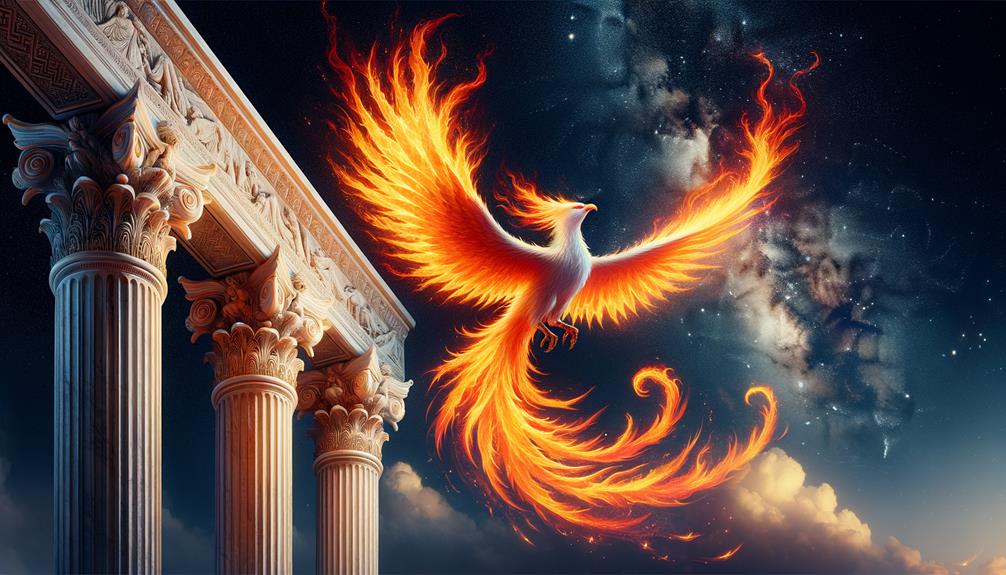The Phoenix, a brilliantly vivid firebird that renews itself from the ashes, is perhaps the most enduring and entrancing mythical character in history. Let's take a closer look at its myth. The Phoenix, with its amazing cycle of rebirth, doesn't just stand for life, death, and resurrection, but also the cyclical flow of time. Its depictions have evolved from ancient Egyptian and Greek mythologies to later interpretations in Christianity and modern literature. The Phoenix has always intrigued us with its incredible power to renew itself from the very fire that destroys it. It's a complex and detailed story that intertwines myth, religion, and cultural symbols. You might ask, why does this unique mythical bird resonate so deeply across different cultures and times? What does it tell us about our shared consciousness and lasting intrigue with ideas of death and rebirth? Let's dive into this captivating exploration to answer these compelling questions.
Origins of Phoenix Mythology

Diving into the roots of Phoenix mythology, we uncover its deep ties to ancient Egyptian sun worship and classical antiquity. A majestic bird, as large as an eagle and decked out in red and gold plumage, is at the heart of this myth. Its song is said to be as beautiful as its vibrant appearance. The Phoenix was seen as a representation of the sun, exuding an energy and brilliance that mirrored the heavenly body it was associated with.
The legend goes that there was only ever one Phoenix at a time, making it a one-of-a-kind creature among mythical beings. This bird had an impressive lifespan of around 500 years. When death was near, it would build a nest using fragrant branches and spices, set it on fire, and allow itself to be consumed by the flames. The real magic, however, was what came next – from the ashes, a new Phoenix would emerge, symbolising both resilience and renewal. This life cycle of the Phoenix, which mirrored the daily rising and setting of the sun, further solidified its link to this heavenly body.
The Phoenix's significance evolved over time. It came to represent the eternal city of Rome and, in more modern interpretations, its themes of rebirth and resilience continue to resound. The Phoenix remains a potent symbol that transcends cultural and historical boundaries.
Symbolism in Phoenix Legends
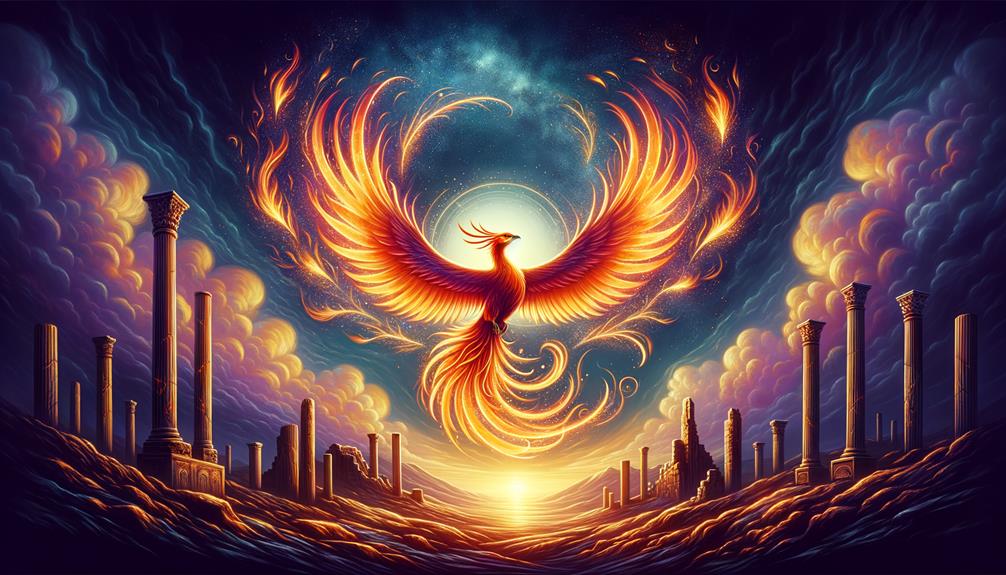
When it comes to the fascinating world of phoenix legends, there's a lot to unpack. You'll find that the phoenix's fiery rebirth plays a big role. It's not just about the cycle of life or the sun's daily trek, but it also taps into powerful themes of starting over and coming back to life that are appreciated in many cultures. The image of rising from the ashes is a compelling metaphor for change, giving a sense of hope and toughness.
Let's take a peek at what the phoenix symbolizes in different cultures:
- Ancient Egypt: Here, they linked the phoenix bird to the sun and the idea of living forever.
- Classical Antiquity: The phoenix stood for coming back to life and starting fresh.
- Islamic Culture: The phoenix kind of matches up with the mythical characteristics of the ʿanqāʾ.
The symbolism in phoenix legends goes beyond borders, making it a pretty universal symbol. The idea of the phoenix as a sign of eternal life is a reminder of life's repeating cycles and the chance for change. Its tale has influenced belief systems and sparked creativity, reinforcing the idea that even from wreckage, life can spring anew. This is the magic and long-lasting legacy of the phoenix legend.
Phoenix in Diverse Cultures
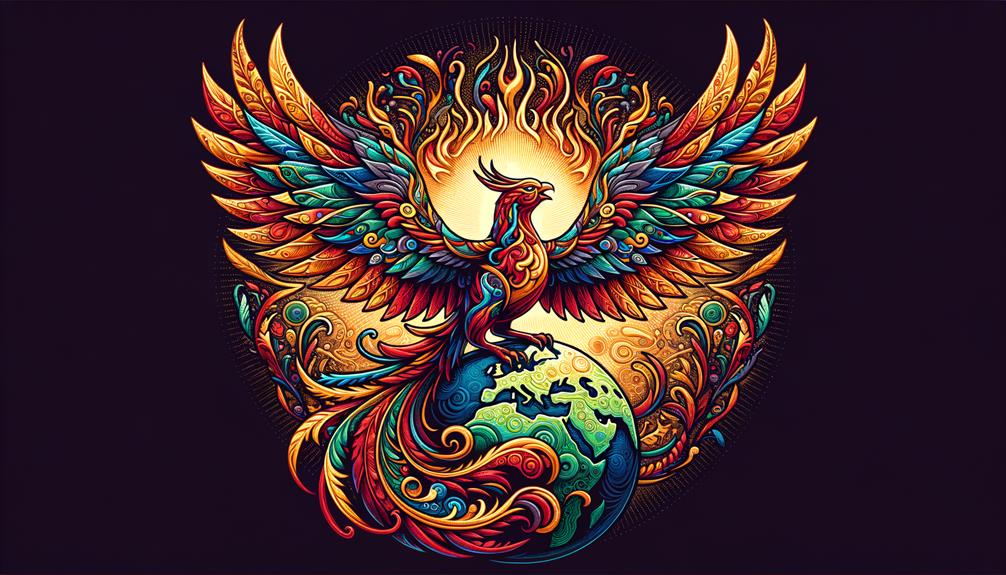
If you take a deeper look into different cultures around the world, one thing you'll surely notice is the significance of the phoenix. This magnificent bird, often showcased in vivid shades of red and gold, is a worldwide emblem of rebirth and resilience. The ancient Egyptians, for instance, saw a link between the phoenix and their sun god, pointing to concepts of renewal and resurrection. It's said that a new phoenix would miraculously spring up from the ashes of its predecessor, thus illustrating the eternal cycle of life and death.
Now, the symbolism of this mythical bird isn't confined to a single culture:
- In Islamic mythology, the phoenix is often seen as the equivalent of the 'anqa', a creature revered for its perfection and mystery.
- It's a prevalent symbol of immortality and renewal in several cultures, like Chinese, Hindu, Slavic, Jewish, and Christian.
- There's usually only one phoenix at a time, underscoring the theme of individuality and uniqueness.
- The phoenix is also viewed as an embodiment of the sun, which 'dies' in flames at the end of the day only to rise again each morning.
Phoenix in Literature and Art
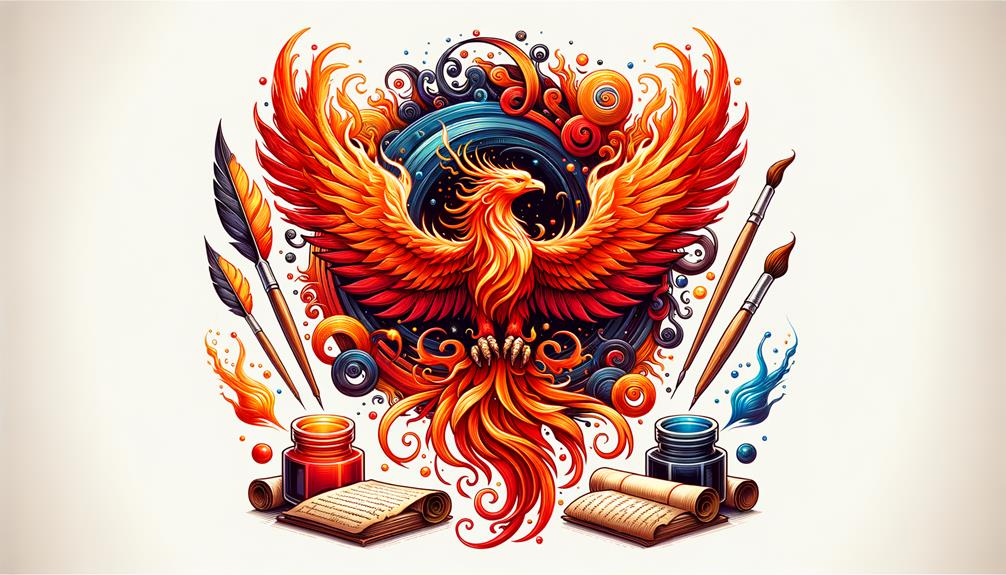
The phoenix is a captivating symbol that has been deeply embedded in art and literature, representing themes like rebirth, resilience, and life's cyclical nature. This iconic bird, familiar to the ancient Greeks, stands as a symbol of immortality and renewal, reflecting the cyclical lifespan of the Phoenix.
Whenever a Phoenix rises from its predecessor's ashes, it carries on the essence of the previous Phoenix. This is similar to how stories and symbols are handed down and reshaped through generations. This rebirth process mirrors the ongoing retelling and reinterpretation of the Phoenix myth in literature and art. The fresh phoenix, emerging from the ashes, represents the enduring power of myth and symbolism in today's culture.
Therefore, the Phoenix acts as a potent metaphor for human experience. It represents our hopes, fears, struggles, and victories. It demonstrates our ability to rise again, to show resilience, and to persist in the face of life and death's cyclical nature. For this reason, the Phoenix continues to mesmerize and inspire us, symbolizing the unbeatable will of the human spirit.
Modern Interpretations of Phoenix
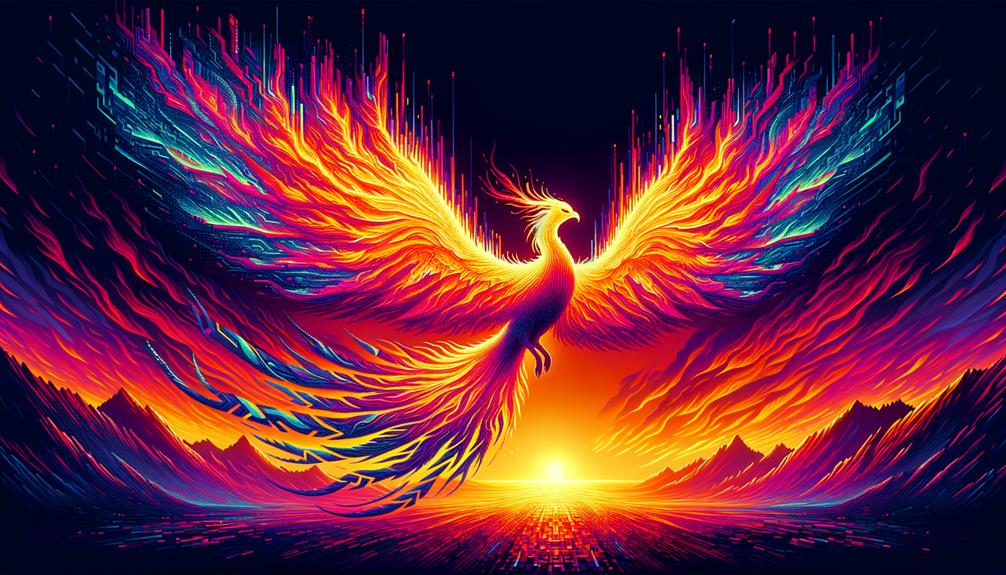
Let's chat about the Phoenix, a symbol that's definitely made its mark on modern literature and pop culture. Now, this isn't just any bird. The Phoenix, with its flaming aura and purple plumage, is a sign of royalty and divinity. It's a timeless symbol of eternal life, a notion that keeps popping up in the way we see it today.
So, how does the Phoenix fit into our world? Here's the scoop:
- The Phoenix brings to mind the cycle of life, the chance for change and fresh starts. It's an idea that hits home for many of us, nudging at our own wish for a do-over or a fresh start.
- Think of the Phoenix as a metaphor in books, symbolizing characters' rebirth following a tough time or big change.
- You can spot the Phoenix in all sorts of places in pop culture, from movies and video games to comic books, appearing in a whopping 37 different ways.
- The golden glow and purple feathers of the Phoenix aren't just for show. They represent its divine roots and royal standing, enriching our understanding of it today.
In short, we still see the Phoenix as a symbol of resilience, an ability to rise from the ashes, and eternal life. The tale of the Phoenix inspires us to welcome change, symbolizing a beacon of hope in challenging times.
Frequently Asked Questions
What Are Phoenix Characteristics?
So, you're curious about Phoenix characteristics? They're fascinating creatures of myth, known for their legendary ability to be reborn from their own ashes – a powerful symbol of eternal life. They're often shown in vivid shades of scarlet and gold, a testament to their fiery existence. These birds are thought to have lifespans that span hundreds of years. They stand as a strong emblem of renewal and resilience, always rising, no matter how hard the fall.
What Does Phoenix Symbolize?
You know, when I think about the Phoenix, I'm struck by what an amazing symbol it is. It stands for a fresh start, the chance to begin again, and it even hints at the possibility of living forever. It's like this great, fiery image of victory over death. You'll often see it linked with the sun, too. And you know what's really neat? This isn't just something I've noticed. People from all sorts of cultures see the Phoenix as a symbol of bouncing back, no matter what life throws at them. It's a reminder that life is full of ups and downs, just like the Phoenix that dies in a burst of flames only to be born again. Isn't that something?
Is Phoenix Bird Good or Evil?
You know, it's not really fair to label a phoenix as either good or evil. This mythical bird is a powerful symbol of rebirth, bouncing back from hardships, and everlasting life. The phoenix being linked with these ideas doesn't signal any sort of moral stance. Instead, it's all about the continuous cycle of starting anew and overcoming tough times.
What Does a Phoenix Look Like in Real Life?
Honestly, a phoenix isn't a creature you'd find in the animal kingdom. It's purely a product of myths and legends. But let's imagine for a moment it did exist. I'd guess it would look something like an eagle, all aflame with bright red and gold. It would likely have a powerful call, one that reflects its enduring spirit.

